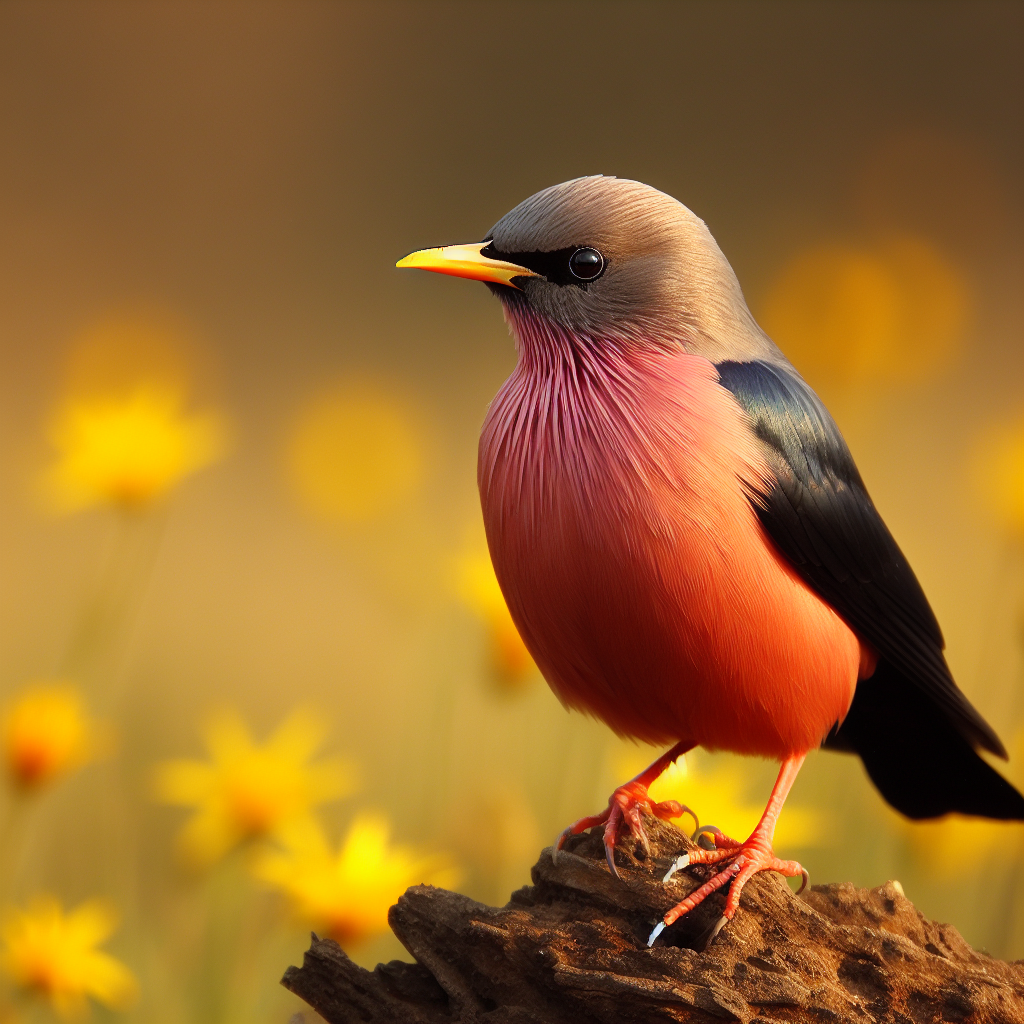Most beautiful small birds - Sykalo Eugen 2024
Rosy Starling (Pastor roseus)
Identification:
- Species name: Rosy Starling
- Scientific name: Pastor roseus
- Family: Sturnidae (Starlings)
- Order: Passeriformes (Songbirds)
- Subclass: Neornithes (Modern birds)
- Class: Aves (Birds)
Description:
- Size: Medium-sized Starling, about 22-24 cm (8.7-9.4 in) long with a wingspan of 44-50 cm (17.3-19.7 in).
- Body shape: Sleek and agile, with a long, pointed tail, a strong, slightly downcurved beak, and a distinctive glossy plumage.
- Plumage color:
Males: Brilliant rosy-pink body, contrasting with their black head, wings, and tail. White wing patches flash in flight.
Females: Duller overall than males, with less extensive pink and more streaking on the underparts. Head may be brown or grayish.
Strong, slightly downcurved beak, black.
Strong, black legs.
Brown eyes.
Behavior:
- Method of feeding: Primarily eats insects and larvae, foraging on the ground, in vegetation, and around livestock. May also eat fruits and berries.
- Reproduction: Builds cup-shaped nests in trees or cliffs. Lays 3-5 glossy green-blue eggs. Both parents care for the young.
- Movement: Highly migratory, breeding in eastern Europe and western Asia and wintering in India and tropical Africa. Forms large, noisy flocks during migration and at wintering grounds.
- Communication: Loud, chattering calls and a variety of whistles and warbles. Males have an elaborate song used to attract mates and defend territory.
Ecology:
- Habitat: Steppes, grasslands, fields, open woodlands, and agricultural areas. Prefers areas with scattered trees and bushes.
- Diet: Insects, larvae, fruits, berries, seeds, and scraps from human settlements.
- Hunting methods: Forages on the ground and in vegetation, picking up insects and seeds. May also glean insects from leaves and branches or follow livestock to scavenge insects disturbed by grazing.
Distribution: Found in eastern Europe, central Asia, and parts of western Asia. Winters in India and Africa.

The Rosy Starling, a feathered jewel painting the steppes with flashes of pink and black, might seem like a simple resident of arid plains at first glance. But beneath its shimmering plumage and melodious chirps lies a treasure trove of surprising facts and adaptations that will transform this steppe sprite into a captivating aerial acrobat, hidden feast master, and unexpected social swinger in your eyes.
Masters of the Steppe Sky: Forget clumsy hops; Rosy Starlings reign supreme in the domain of windswept grasslands and sun-dappled skies. Their powerful wings and surprisingly acrobatic skills propel them through the air with breathtaking agility, weaving and diving like feathered fighter jets with built-in miniature wingsuits. Imagine them as steppe ballet dancers in a synchronized aerial performance, painting the azure canvas with fleeting patterns of pink and black.
Hidden Feasting Technique: Don't underestimate their dietary flexibility! While insects are a staple, Rosy Starlings are opportunistic omnivores, readily adapting their menu to seasonal bounty. From juicy fruits and tender shoots to seeds and even the occasional small reptile, their varied appetite keeps them fueled for energetic foraging sessions. Think of them as feathered savanna samplers with built-in miniature buffets hidden within the sun-baked plains.
Singing with Steppian Spirit: Their chirps aren't just simple calls. Rosy Starlings possess a rich and distinctive repertoire, with clear, whistling songs, intricate trills, and even a signature "tee-tee-too" duet call that echoes across the steppes. Their voices rise above the grasslands like feathered woodwind players, serenading the sun-dappled breeze with their spirited calls and playful partnership.
Unexpected Social Swingers: They're not always solitary flyers. Rosy Starlings form large and boisterous flocks, especially during migration and foraging seasons. These feathered skydivers, in synchronized aerial dives, paint fleeting pink streaks across the azure canvas, their collective hum filling the air with a captivating symphony of life.
Champions of Ecosystem Health: They're not just colorful residents. Rosy Starlings play a vital role in the health of arid ecosystems. Their insect feasting controls pest populations, while their droppings fertilize the soil, making them feathered steppe doctors with built-in miniature pest-control systems and environmental beautification kits.
Cultural Charmers: Across Eurasia and Africa, the Rosy Starling has held diverse cultural significance. In some regions, it's seen as a symbol of good luck and prosperity, its vibrant plumage inspiring hope and joy. In others, its synchronized aerial displays have led to associations with community and cooperative spirit.
Unexpected Regional Variations: Did you know? Not all Rosy Starlings are the same! Different populations across their vast range show subtle variations in plumage color and call patterns, adding a touch of feathered diversity to this adaptable species.